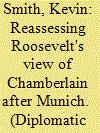|
|
|
Sort Order |
|
|
|
Items / Page
|
|
|
|
|
|
|
| Srl | Item |
| 1 |
ID:
115354


|
|
|
|
|
| Publication |
2012.
|
| Summary/Abstract |
Houston Stewart Chamberlain is best known as an anti-Semite; however, the British-born independent scholar was also a fervent German nationalist. His major anti-Semitic work, Die Grundlagen des 19. Jahrhunderts (The Foundations of the Nineteenth Century), was first published in 1899 and masqueraded as a history of Europe. His most important nationalist works were his Kriegsaufsätze (war essays), published beginning in 1914. This article examines the discursive methods used by Chamberlain to create images of the German Self and its enemy Other in both Die Grundlagen and the war essays. The enemy Other in Die Grundlagen was portrayed as the destructive force represented by Jews; the Self was the creative or regenerative will and abilities of Aryans. In the war essays, the enemy Other was, to start with, the Russians, French, and English, and, later on, just the English (Chamberlain did not refer to the British). The war essays were subject to censorship and so could only make negative references to Jews 'between the lines'; Chamberlain, however, was careful to point out to his readers that they should look for hidden messages.
|
|
|
|
|
|
|
|
|
|
|
|
|
|
|
|
| 2 |
ID:
091278


|
|
|
|
|
| Publication |
2009.
|
| Summary/Abstract |
The absence of active Anglo-American cooperation in the late 1930s contributed to an international environment in which Adolf Hitler could maneuver, capitalizing on Neville Chamberlain's zeal for an Anglo-German settlement of outstanding grievances. The reasons for this estrangement included British suspicion of America's power, intentions, and reliability, manifested notably in U.S. rejection of the League of Nations and withdrawal from the 1933 London Economic Conference. British war debt default and failure to coordinate a response in Manchuria angered Americans. Finally, mutual erection of tariff walls and-especially-both peoples' desire to avoid war imposed domestic political constraints.1 Any conventional summary of Anglo-American relations in this era includes reference to the lack of personal affinity between Franklin Roosevelt and Neville Chamberlain. In 1936, Roosevelt had remarked, "We must recognize that he thoroughly dislikes Americans." In December 1937, Chamberlain told his sister, "It is always best and safest to count on nothing from the Americans except words" and advised the cabinet, "the Power that had the greatest strength was the USA, but he would be a rash man who based his calculations on help from that quarter."2 These attitudes were influential. Unpublished private letters from Geoffrey Thompson, an official in the Foreign Office's American Department recently recalled from Spain, to Claude Bowers, U.S. ambassador to Spain, help illustrate the importance of mistrust and the obstacles to a different path in the winter of 1938-1939.
|
|
|
|
|
|
|
|
|
|
|
|
|
|
|
|
|
|
|
|
|